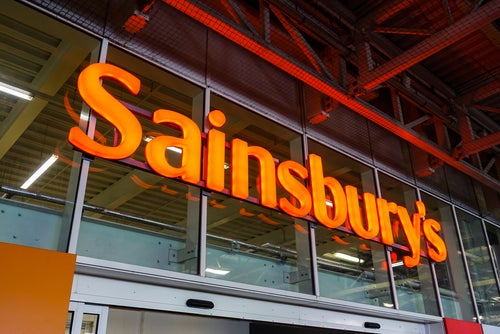
In its Q1 results, Sainsbury‘s reported a general return to volume growth across the company but clothing sales declined during the 16-week period.
Clothing sales were impacted by the cooler weather, with stronger sales in the later weeks of the quarter as the weather improved.
The Tu brand owner explained that positive growth in clothing sales was achieved even on full-price sales, despite a highly promotional market environment.
It also acknowledged the positive impact of its clothing online segment which “benefited from the migration to the Argos web platform and the introduction of more third-party brands”.
Sainsbury’s stocks womenswear brand Sosandar and earlier this year announced it would stock Little Mistress.
In May, it was reported that Sainsbury’s aimed to expand its offerings by incorporating more third-party brands and establishing an online marketplace similar to those operated by prominent retailers like M&S, Next, and John Lewis.
Sainsbury’s clothing unit has been experiencing a downward trend in sales over the past few quarters with a 1.9% sales fall in Q4, a 1.3% rise in Q3, a 0.2% fall in Q2 and a 10.1% drop in Q1 a year ago.
Key takeaways from Sainsbury’s Group Q1 results:
- The company reported a 9.8% growth in like-for-like sales, while total retail sales rose by 9.2%
- Strong Grocery performance, with sales up 11%
- General Merchandise sales up 4%
- Argos, a subsidiary of Sainsbury’s, witnessed a 5.1% surge in sales
- The group continues to expect FY23/24 underlying profit before tax of between £640m ($812m) and £700m
Simon Roberts, chief executive of Sainsbury’s, said: “Customers can see that prices at Sainsbury’s have improved and this combination of great value and some good weather in recent weeks means we have grown our food volumes and market share.”
Rebecca Crook, chief growth officer EMEA at CI&T considered what Sainsbury’s must do to maintain it’s expanded customer base and said: “That sales increased almost 10% is no surprise given the Easter period, Bank Holidays and warmer weather.
“Sainsbury’s has also been one of the few retailers to hold firm from hiking their prices, which has gained them market share and new customers. The launch of Nectar Prices this year has enabled savings in some cases up to 60% off branded items both in store and online, helping to win over thrifty shoppers who choose to shop with retailers that offer the best value for money.
“This is still a hugely challenging period for retailers and Sainsbury’s, amongst others, will need to think carefully about how to keep customers coming back. Investing in technology like AI is key to driving greater efficiencies, but it can also enhance creativity. At Sainsbury’s, we’ve seen more personalised communications with consumers – for example, how to make recipes at home in more cost-effective ways. Tailoring comms and offering incentives based on shoppers’ needs will help retailers boost market share even more.”
Grocery sales soar as Sainsbury’s focuses on delivering value, says GlobalData
Eleanor Simpson-Gould, senior retail analyst at GlobalData, a leading data and analytics company, offers her view:
“The first 16 weeks of FY2023/24 mark strong quarterly growth for Sainsbury’s, with like-for-like (l-f-l) sales increasing 9.8%, powered by a positive response to the retailer’s initiatives on price, effective event marketing and favourable weather towards the end of the period. Grocery was the standout category, accelerating from 7.4% in Q4 to 11.0%, albeit against a 2.4% decline in sales in in Q1 FY2022/23. Sainsbury’s latest results trump growth from market leader Tesco, who announced Q1 growth of 8.2% for the 13 weeks ending 27 May 2023. With inflation showing early signs of easing and the underlying profit outlook for the coming year remaining unchanged, Q1 may well mark the peak of grocery sales growth for Sainsbury’s in this financial year.
“With retailers under pressure from shoppers and the government to deliver lower prices, Sainsbury’s is actively responding. In April, Nectar Prices promotions were opened up to all loyalty scheme members, a move that has boosted membership of the scheme by over one million customers. The retailer has also consolidated its entry level private label using the Stamford Street brand, which has helped to grow own brand sales by 13%. At the same time, it has extended the number of products covered by its Aldi Price Match guarantee to 370, a move that should also boost loyalty. Already this tactic appears to be paying off, with the number of consumers stating they are switching away from Sainsbury’s, down from 21.3% in May 2023 to 17.1% June 2023, according to GlobalData’s consumer surveys of 2,000 respondents.
“As inflation eases in the latter half of 2023, Sainsbury’s will remain under scrutiny to pass on reductions in buying prices to customers amid investigations into supermarket profiteering and retention of new customers will require continued ambition on pricing to sustain volume growth. However, enticing shoppers to trade up into higher price points will ease the inevitable decline in sales growth, Nectar Price promotions will be key to introduce wider ranges to shoppers’ baskets. Continuing investment in product innovation will also be important to encourage shoppers to trade up to premium ranges, with Sainsbury’s looking to build on the 300 new products ranges launched during Q1.
“Total General Merchandise sales achieved 4.0% growth in Q1, falling short of the 7.6% growth achieved in Q4 due to closure of stores in Ireland earlier in the year and the late onset of spring weather diluting performance. With 5.1% growth in the quarter, Argos remains the stabilising force in Sainsbury’s non-food proposition, which was pulled down by a -3.7% fall in clothing sales in Q1 and a 1.2% decline in sales of Sainsbury’s own general merchandise offer. Incorporation of third-party clothing brands and efforts to boost online presence of TU through Argos remain a work in progress. With a strong heritage as a value focused brand, Argos has the potential to boost Sainsbury’s traction with shoppers facing an ongoing squeeze on disposable income in the months ahead.”



